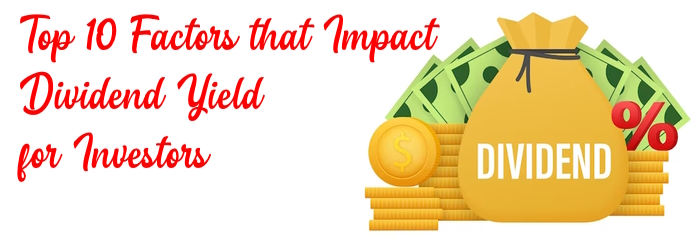Top 10 Factors that Impact Dividend Yield for Investors
Dividend yield is a crucial metric that investors use to assess the performance of a company and determine the potential returns on their investments. The dividend yield is calculated by dividing the annual dividend per share by the current market price per share. The resulting percentage indicates the amount of cash flow generated by a company in the form of dividends relative to the price of its shares.
A high dividend yield can be an attractive feature for investors, as it indicates that a company is generating a significant amount of cash flow and returning it to shareholders. Several factors can affect dividend yield, and this article discusses the top 10 factors that impact dividend yield.

Table of Contents
Factors Impacting Dividend Yield for Investors
1. Earnings and Cash Flow
The most significant factor that affects dividend yield is the earnings and cash flow of a company. A company that generates substantial earnings and cash flow is more likely to have a higher dividend yield. This is because the company can afford to pay higher dividends and still have enough cash to reinvest in the business. For example, Microsoft Corporation (MSFT) has consistently paid dividends and increased its dividend yield over the years due to its strong earnings and cash flow.
2. Business Cycles
Business cycles can also impact dividend yield. During an economic downturn, companies may cut their dividends to conserve cash and maintain liquidity. Conversely, during an economic boom, companies may increase their dividends to reward shareholders and attract more investors. For example, during the COVID-19 pandemic, many companies in the travel and hospitality sectors, such as Marriott International (MAR), reduced or suspended their dividends due to reduced earnings and cash flow.
3. Industry Trends
The industry in which a company operates can also impact its dividend yield. Companies in mature and stable industries, such as utilities and consumer staples, tend to have higher dividend yields as they have more predictable cash flows. For example, The Southern Company (SO), an electric utility company, has consistently paid a high dividend yield due to its stable earnings and cash flow.
4. Capital Expenditures
The amount of capital expenditures a company makes can also impact its dividend yield. Companies that have high capital expenditure requirements may have lower dividend yields, as they need to retain more earnings to invest in growth opportunities. For example, Amazon.com Inc. (AMZN) has a low dividend yield due to its high capital expenditure requirements to invest in new warehouses and logistics infrastructure.
5. Debt Levels
The level of debt a company has can also impact its dividend yield. Companies with high levels of debt may have lower dividend yields as they need to retain more earnings to pay down their debt obligations. For example, General Electric Company (GE) has a lower dividend yield due to its high debt levels and the need to use earnings to pay down its debt.
6. Regulatory Environment
The regulatory environment in which a company operates can also impact its dividend yield. Companies in heavily regulated industries, such as healthcare and energy, may have lower dividend yields due to increased regulatory requirements and compliance costs. For example, Pfizer Inc. (PFE) has a lower dividend yield due to the heavily regulated nature of the pharmaceutical industry.
7. Tax Policy
Tax policies can also impact dividend yield. Companies that operate in countries with higher tax rates may have lower dividend yields as they need to retain more earnings to pay taxes. For example, companies in Japan, which has a high corporate tax rate, tend to have lower dividend yields compared to companies in the US.
8. Market Conditions
Market conditions can also impact dividend yield. During periods of market volatility, companies may reduce their dividends to conserve cash and maintain liquidity. Conversely, during periods of market stability and growth, companies may increase their dividends to reward shareholders and attract more investors.
9. Management Policies
The policies and strategies of a company’s management team can also impact dividend yield. Companies that prioritize dividend payments as part of their capital allocation strategy tend to have higher dividend yields. For example, Johnson & Johnson (JNJ) has a history of paying dividends and increasing its dividend yield as part of its long-term capital allocation strategy.
Finally, share repurchases can also impact dividend yield. Companies that prioritize share repurchases may have lower dividend yields as they are returning capital to shareholders through buybacks instead of dividends. For example, Apple Inc. (AAPL) has a lower dividend yield due to its share repurchase program, which has been a major part of its capital allocation strategy in recent years.
Conclusion
Dividend yield is an important metric that investors use to evaluate the performance of a company and determine potential returns on their investments. Several factors impact dividend yield, including earnings and cash flow, business cycles, industry trends, capital expenditures, debt levels, regulatory environment, tax policy, market conditions, management policies, and share repurchases.
By considering these factors, investors can make informed decisions about their investments and build a well-diversified portfolio that includes companies with attractive dividend yields.


